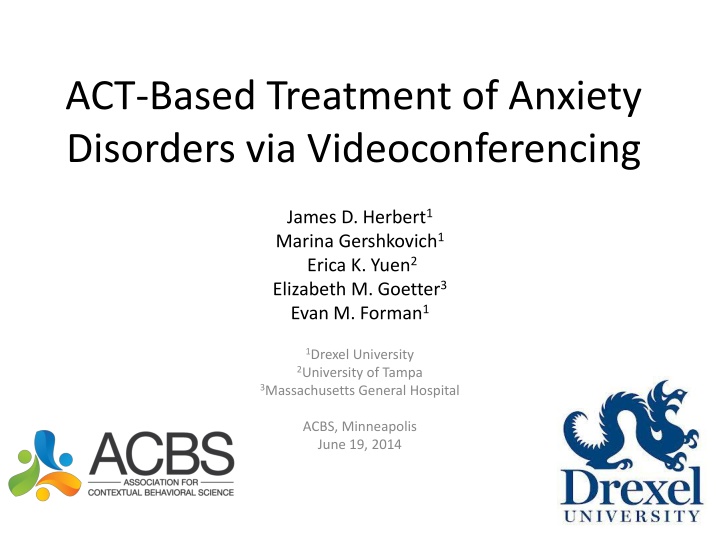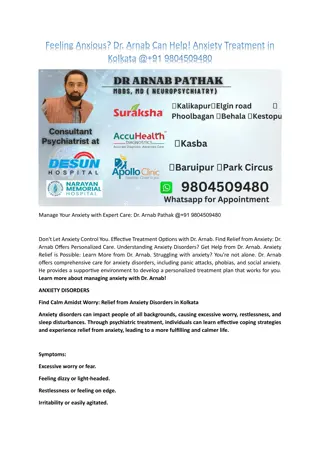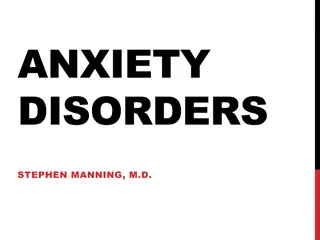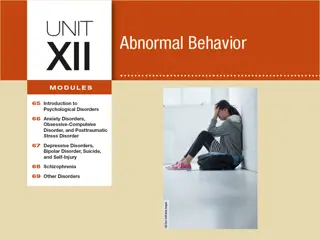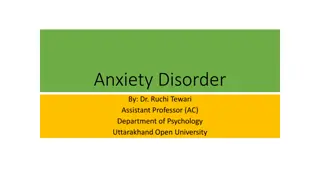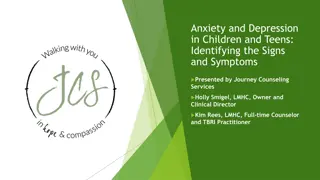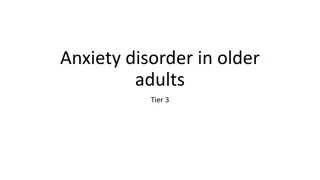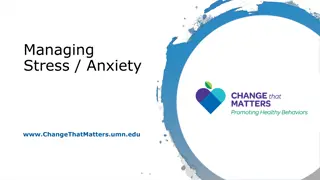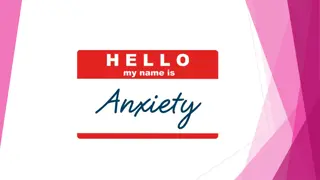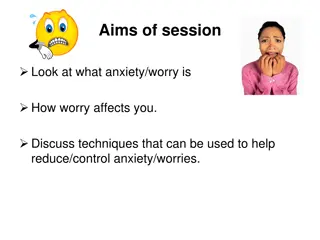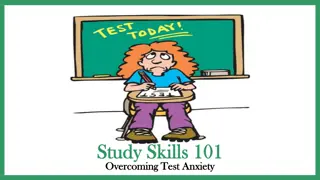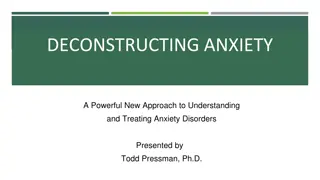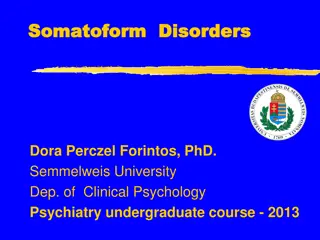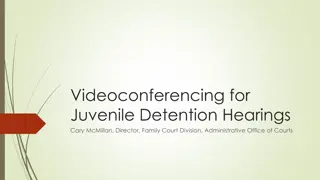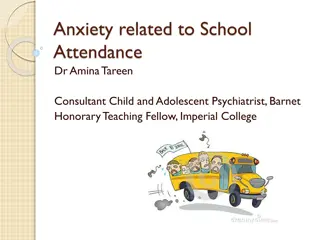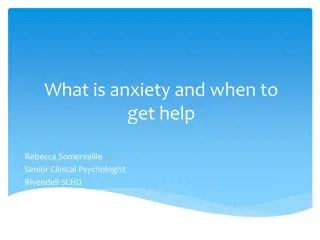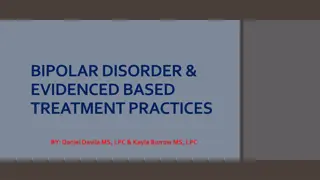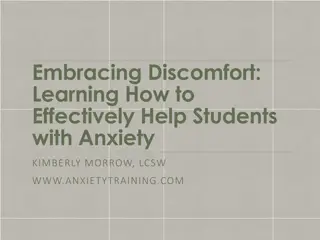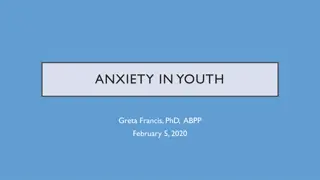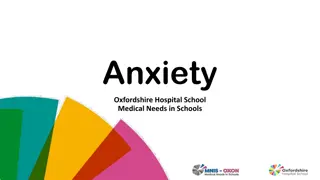Enhancing Access to Anxiety Disorder Treatment through Videoconferencing
This study explores how videoconferencing can bridge the gap in accessing effective treatments for anxiety disorders, particularly social anxiety disorder (SAD). By utilizing real-time communication, videoconferencing reduces logistical barriers, making therapy more accessible for individuals in non-metropolitan areas. Research indicates promising outcomes for acceptance-based behavior therapy via videoconferencing. Exposure-based procedures, a key component in cognitive-behavioral therapy models, are also considered suitable for videoconferencing delivery.
Download Presentation

Please find below an Image/Link to download the presentation.
The content on the website is provided AS IS for your information and personal use only. It may not be sold, licensed, or shared on other websites without obtaining consent from the author.If you encounter any issues during the download, it is possible that the publisher has removed the file from their server.
You are allowed to download the files provided on this website for personal or commercial use, subject to the condition that they are used lawfully. All files are the property of their respective owners.
The content on the website is provided AS IS for your information and personal use only. It may not be sold, licensed, or shared on other websites without obtaining consent from the author.
E N D
Presentation Transcript
ACT-Based Treatment of Anxiety Disorders via Videoconferencing James D. Herbert1 Marina Gershkovich1 Erica K. Yuen2 Elizabeth M. Goetter3 Evan M. Forman1 1Drexel University 2University of Tampa 3Massachusetts General Hospital ACBS, Minneapolis June 19, 2014
Current Landscape of Behavioral Treatment of Anxiety Disorders Highly effective treatments Accessibility continues to be a problem
Several million Americans with anxiety disorders do not have access to a therapist Geographical Distribution of US Population Non metropolitan Metropolitan 50 million people live in non-metropolitan areas of the US non
Bridging the Gap? Videoconference-mediated treatments show promise Real-time video/audio communication Reduce logistical barriers (e.g., distance, time) May increase willingness to engage in tx But Research is preliminary Many VC technologies can be expensive (e.g. VA) Dedicated broadband vs. low-tech options Exposure-based treatments for anxiety can be difficult
Exposure-Based Procedures Key component across various models of CBT ACT model well suited to EXP tx How well can in-session exposures be accomplished via videoconferencing?
Study 1: VC Treatment of SAD Yuen, E. K., Herbert, J. D., Forman, E. M., Goetter, E. M., Juarascio, A. S., Rabin, S., Goodwin, C., & Bouchard, S. (2013). Acceptance based behavior therapy for social anxiety disorder through videoconferencing. Journal of Anxiety Disorders, 27, 389-397. ACT
Social Anxiety Disorder (SAD) Excessive fears of being embarrassed and negatively evaluated by other people Most individuals with SAD do not receive treatment Fear of social interactions Geographic location Transportation limitations Stigma
Procedures Online advertisements and clinic referrals Telephone screen Structured clinical interview Skype lesson / test call Baseline self-report questionnaires 1 month waiting period Pre-treatment self-report questions
Treatment 12 one-hour sessions of weekly therapy in Skype Manualized treatment protocol, combining simulated exposures (Heimberg, Clark) within an ACT framework (Herbert, Forman & Dalrymple, 2009). Sessions 1-2: Psychoeducation Sessions 3-12: In-session exposures, e.g.: Deliver speech to audience Ask person on date Ask for raise Social skills training PRN ACT concepts (willingness, acceptance, values, mindfulness, defusion) integrated throughout Homework
Participants N = 24 adults in the US, dx generalized SAD via SCID-IV Age: 19 to 63 (M=35; SD=10.8) Gender: 75% male Ethnicity: 75% Caucasian, 8% Asian, 4% Black or African American, 4% Hispanic/Latino, 4% Other Prior Skype experience: 54% had prior Skype experience
Results: Feasibility/Acceptability Satisfaction with Treatment Satisfaction with Therapist Completely Satisfied 86% Completely Satisfied 47% Mostly Satisfied 48% Mostly Satisfied 14% Neutral 5% Neutral 0% Not at all Satisfied 0% Somewhat Satisfied 0% Somewhat Satisfied 0% Not at all Satisfied 0% Dropout: 17%
Results: Feasibility/Acceptability Difficulty of Receiving Treatment Through Videoconferencing Fairly easy 62% Very easy 33% Neutral 5% Very difficult 0% Fairly difficult 0%
Feasibility/Acceptability Technical Difficulties None Insignificant Minor Moderate Major Severe 26% All Sessions 46% 15% 8% 3% 2%
Feasibility/Acceptability Technical Difficulty % of Sessions Sound quality (e.g., choppy, soft, echoing, delay) Video quality (e.g., choppy, blurry, freezing, delayed) Dropped or frozen video call Unable to see video Unable to hear sound 30% 27% 6% 5% 3% Technical difficulties not associated with treatment outcome: SPAI (r=-.04, p=.85), LSAS-Total (r=.12, p=.58), Brief-FNE (r=.18, p=.39)
Results: Feasibility/Acceptability Technical Difficulties Insignificant Minor None Moderate Major Severe First 10% of sessions 30% 15% 41% 7% 7% Last 90% of sessions 48% 15% 25% 8% 4% 1% Early sessions (first 10%) had greater technical difficulties, X2(1, N = 263) = 3.39, p =.065.
Results: Feasibility/Acceptability Convenience "It was convenient as I was able to meet with my therapist whether I was at home or on the road. "I am a full time mother, so getting to stay in the comfort of my own home was extremely beneficial." http://www.chicagocarless.com/wp-content/uploads/no-cars1.jpg
Results: Feasibility/Acceptability Ease of communication With the exception of one week where we had connectivity issues, it was fairly easy to communicate through Skype. I feel like it was just as effective as meeting in person would have been. "Somewhat awkward at first, but it felt more natural before long."
Results: Feasibility/Acceptability Technical Difficulties "Very easy to connect, video and voice quality were usually great. "Sometimes I had some connection issues."
Results: Treatment Outcome Effect size (Cohen s d) 2.10 1.35 1.20 1.41 0.91 2.35 0.55 0.87 Pre-tx Mean 138.57 42.17 38.25 50.21 15.92 21.71 -0.09 29.50 Post-tx Mean 89.07 27.92 19.79 39.13 6.13 9.38 0.96 23.42 3-month FU mean 84.06 27.79 22.33 37.50 5.63 9.21 0.99 20.13 F p SPAI-SP LSAS-Fear LSAS-Avoidance Brief-FNE BDI SDS-Total QOLI AAQ-II 19.59 17.81 14.25 16.27 6.77 14.76 3.02 7.26 <.01 <.01 <.01 <.01 <.01 <.01 .05 <.01
Results: Treatment Outcome SPAI-SP Depression (BDI-II) 18 160 15 140 12 120 9 100 6 80 3 0 60 Pre-Tx Mid-Tx Post-Tx FU Pre-Tx Mid-Tx Post-Tx FU
Results: Treatment Outcome Quality of Life Inventory (QOLI) Disability (SDS) 1.2 25 0.8 20 15 0.4 10 0 5 0 -0.4 Pre-Tx Mid-Tx Post-Tx FU Pre-Tx Mid-Tx Post-Tx FU
Results: Treatment Outcome 140 120 Pre-tx to FU Effect Sizes: 100 SPAI_SP Pre- Tx SPAI_SP FU 80 Skype: d = 2.10 60 In-Person: d = 1.41 40 20 0 Skype In-Person Clinic
Okay, so this seems to work for SAD. What about a real challenge, like OCD?
Study 2: VC treatment of OCD Goetter, E. M., Herbert, J. D., Forman, E. M., Yuen, E. K., & Thomas, J. G. (2014). An open trial of videoconference-mediated exposure and ritual prevention for obsessive-compulsive disorder. Journal of Anxiety Disorders, 28(5), 460-462. Goetter, E. M., Herbert, J. D., Forman, E. M., Yuen, E. K., Gershkovich, M., Glassman, L. H., Rabin, S., & Goldstein, S. P. (2013). Delivering exposure and response prevention for Obsessive Compulsive Disorder via videoconference: Clinical considerations and recommendations. Journal of Obsessive-Compulsive and Related Disorders, 2(2), 137-143.
Challenges of ERP for OCD Heterogeneity of OCD Complexity of OCD Covert compulsions Subtle avoidance behaviors Therapist (usually) must be very active, hands-on
Participants Exclusion: Inclusion: Comorbid psychotic disorder Hoarding subtype Acute suicide potential Seeking additional therapy for OCD Not on a stable medication regimen for prior 3 months Adults with OCD Living in eligible state YBOCS 16 Access to Skype via computer and broadband connection English fluency
Participants N = 15 adults 87% female Age= M=30.2 47% had a college degree 47% employed full-time 67% lived in nonmetropolitan areas, 40% lived >45 mins away from a specialist 47% familiar with Skype 67% had been in therapy before
Protocol 16-18, 90-min, twice weekly sessions Starting in session 3, 60 mins of therapist- guided exposure Exposure and ritual monitoring homework every session Phone check-ins between sessions Assessments at pre-, mid-, post-, and 3-month follow up
Feasibility and Acceptability Attrition rate = 23% 82% mostly or completely satisfied with tx/therapist 91% reported receiving tx was very or fairly easy Therapists reported tx very or fairly easy in 73% of cases Homework adherence (M = 4.43) was comparable to in- person study (M = 5.17) Most agreed (95% indicated > 70% agreement) that the videoconference environment was natural
Technological Problems by Session No technical problems for over half (57%) of all sessions Severe or major technological problems were rare (3.5% of sessions) Frequency of Technological Problems by Session 14 12 10 8 6 # of Tech Problems 4 2 0 1 2 3 4 5 6 7 8 9 101112131415161718
Effect Sizes *Videoconference study
Study 3: Internet-based Self-Help for SAD with Remote Therapist Support
Web-Based Treatment Program 8 modules of ACT, adapted from our in-person SATP protocol (Herbert, Forman, & Dalrymple, 2009) Presented in an online presentations (30-45 minutes) per module per week Core concepts: mindfulness, willingness, defusion exercises, & social skills training Quizzes to assess understanding before progressing to the next module Supplemented by reading materials, exercises, and video clips Exposure Homework
Outline Module Description of Content Introduction; Overview of ACT; creative hopelessness; control as the problem 1 Role and effects of safety behaviors and self-focused attention; gentle refocusing strategy; EXPOSURES , and fear hierarchy 2 Willingness; social skills 3 Values 4 Cognitive defusion 5 Mindfulness 6 Conceptualized/observing self 7 Post-treatment plan; relapse prevention 8
Recruitment Local and national advertisements Online SAD message boards Facebook Ads Referrals
Participants 13 Adults 69.2% female Ages 23 57; mean age 33.2 (SD = 10.4) 69.2 % Caucasian, 69.2% employed full-time, 46.2% single, 53.8% had a college degree Past tx history: 9 of 13 had received tx in the past 2 received group CBT (more than 15 years ago) 2 SAD tx in context of other tx
Procedures Initial contact for study information (n=67) Phone screen (n=35) Diagnostic Assessment (n=18) Began treatment (n=13) Completed treatment (n=13)
Therapist Support From Skype.com
Skype Therapist Check-In 10-15 minutes (1x/week) provide support (e.g., empathic listening) clarify treatment concepts as needed trouble-shooting (e.g. exposure ideas) address technological questions discuss general issues with treatment Video Serves a dual purpose Also a social exposure? CBT
Results: Acceptability & Feasibility Attrition was 0%! 92.3% completely or mostly satisfied with tx & therapist 92.3% found receiving the program as very or fairly easy 80.4% did not experience any technical difficulties during Skype therapist support 92.3% found therapist support helpful/very helpful All said that they would recommend to a friend
Symptom Improvement Pre Tx Mean Post Tx Mean t p Effect Size (d) SPAI-SP 139.53 89.07 5.61 < .001 1.47 LSAS- Total 78.85 51.85 5.33 < .000 0.92 LSAS- Fear 41.85 28.23 6.48 < .001 0.90 LSAS-Avoid 37.00 23.62 4.11 = .001 0.88 CGI-Sev 4.75 3.75 3.63 = .004 0.99 Brief-FNE 50.23 39.85 4.33 = .001 1.17 BDI 13.31 5.69 3.46 = .005 1.11
Treatment Outcome Self-report SPAI-SP 160 140 120 100 80 60 40 20 0 Pre-tx Mid-tx Post-tx
